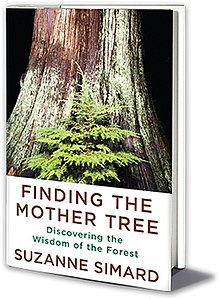 First edition (US) | |
| Author | Suzanne Simard |
|---|---|
| Audio read by | Suzanne Simard |
| Cover artist | Photo: Paul Colangelo, jacket design: Kelly Blair |
| Language | English |
| Subject |
|
| Published | 2021
|
| Publication place | United States |
| Media type |
|
| Pages | 337 |
| ISBN | 978-0525656098 hardcover |
| Website | suzannesimard |
Finding the Mother Tree is a memoir by the Canadian forest ecologist Suzanne Simard. It has been reviewed in The New York Times,[1] The Guardian,[2] The Washington Post,[3] The Wall Street Journal,[4] among other publications.[5]
In her memoir, Simard asserts that trees in forests are interdependent with fungi mycelium. Trees and other plants exchange sugars through their respective root and mycelial structures to share and trade micronutrients. Simard presents her research that fungi physically and chemically connect with the root systems of multiple trees, across species, to create micronutrient pipelines of exchange within a forest community to share these nutrients as well as other molecules. This challenges the "prevailing theory that cooperation is of lesser importance than competition in evolution and ecology."[4]
Simard asserts that healthy forests center on a matriarch tree that acts as a nexus of nutrient distribution that shares these nutrients among other trees of the same or different ages and species that are chemically and physically linked together by an expansive mycorrhizal network.[1] These large-scale, old "mother trees" serve as hubs within the forest network, to deliver carbon to young seedlings through their roots underground in cooperation with fungi.[6]
Simard faced ridicule and gendered attacks by male colleagues during her younger years; however her research became "critical to addressing problems in the timber industry" that led to reforms in sustainable forestry.[4][1]
- ^ a b c Slaught, Jonathan C. (May 3, 2021). "The Woman Who Looked at a Forest and Saw a Community". The New York Times. Archived from the original on May 19, 2021. Retrieved December 5, 2023.
- ^ Francis-Baker, Tiffany (May 8, 2021). "Finding the Mother Tree by Suzanne Simard review – a journey of passion and introspection". The Guardian. Retrieved November 16, 2023.
- ^ Brown, Kate (May 21, 2021). "A scientist's career in communion with trees". The Washington Post. Archived from the original on March 29, 2023. Retrieved November 16, 2023.
- ^ a b c Bone, Eugenia (May 7, 2021). "'Finding the Mother Tree' Review: Seeing the Forest". The Wall Street Journal. Archived from the original on May 19, 2021. Retrieved December 7, 2023.
- ^ "Suzanne Simard's New Book Earns International Acclaim". UBC Faculty of Forestry. University of British Columbia. May 20, 2021. Archived from the original on October 3, 2022.
- ^ Popkin, Gabriel (November 7, 2022). "Are Trees Talking Underground? For Scientists, It's in Dispute". The New York Times. Archived from the original on November 8, 2022. Retrieved December 4, 2023.